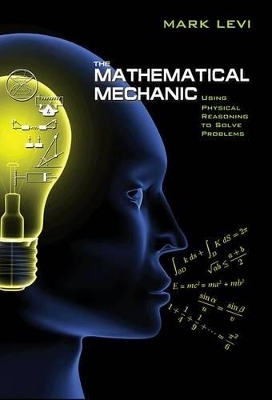
The Mathematical Mechanic
Using Physical Reasoning to Solve Problems
Seiten
2012
Princeton University Press (Verlag)
978-0-691-15456-5 (ISBN)
Princeton University Press (Verlag)
978-0-691-15456-5 (ISBN)
Did you know it's possible to derive the Pythagorean theorem by spinning a fish tank filled with water? Or that the line of best fit for a data set can be found using a mechanical contraption made from a rod and springs? This title demonstrates how to use physical intuition to solve these and other math problems.
Everybody knows that mathematics is indispensable to physics--imagine where we'd be today if Einstein and Newton didn't have the math to back up their ideas. But how many people realize that physics can be used to produce many astonishing and strikingly elegant solutions in mathematics? Mark Levi shows how in this delightful book, treating readers to a host of entertaining problems and mind-bending puzzlers that will amuse and inspire their inner physicist. Levi turns math and physics upside down, revealing how physics can simplify proofs and lead to quicker solutions and new theorems, and how physical solutions can illustrate why results are true in ways lengthy mathematical calculations never can. Did you know it's possible to derive the Pythagorean theorem by spinning a fish tank filled with water? Or that soap film holds the key to determining the cheapest container for a given volume? Or that the line of best fit for a data set can be found using a mechanical contraption made from a rod and springs? Levi demonstrates how to use physical intuition to solve these and other fascinating math problems.
More than half the problems can be tackled by anyone with precalculus and basic geometry, while the more challenging problems require some calculus. This one-of-a-kind book explains physics and math concepts where needed, and includes an informative appendix of physical principles. The Mathematical Mechanic will appeal to anyone interested in the little-known connections between mathematics and physics and how both endeavors relate to the world around us.
Everybody knows that mathematics is indispensable to physics--imagine where we'd be today if Einstein and Newton didn't have the math to back up their ideas. But how many people realize that physics can be used to produce many astonishing and strikingly elegant solutions in mathematics? Mark Levi shows how in this delightful book, treating readers to a host of entertaining problems and mind-bending puzzlers that will amuse and inspire their inner physicist. Levi turns math and physics upside down, revealing how physics can simplify proofs and lead to quicker solutions and new theorems, and how physical solutions can illustrate why results are true in ways lengthy mathematical calculations never can. Did you know it's possible to derive the Pythagorean theorem by spinning a fish tank filled with water? Or that soap film holds the key to determining the cheapest container for a given volume? Or that the line of best fit for a data set can be found using a mechanical contraption made from a rod and springs? Levi demonstrates how to use physical intuition to solve these and other fascinating math problems.
More than half the problems can be tackled by anyone with precalculus and basic geometry, while the more challenging problems require some calculus. This one-of-a-kind book explains physics and math concepts where needed, and includes an informative appendix of physical principles. The Mathematical Mechanic will appeal to anyone interested in the little-known connections between mathematics and physics and how both endeavors relate to the world around us.
Mark Levi is professor of mathematics at Pennsylvania State University and the author of Why Cats Land on Their Feet (Princeton).
*FrontMatter, pg. i*Contents, pg. v*1 Introduction, pg. 1*2 The Pythagorean Theorem, pg. 9*3 Minima and Maxima, pg. 27*4 Inequalities by Electric Shorting, pg. 76*5 Center of Mass: Proofs and Solutions, pg. 84*6 Geometry and Motion, pg. 99*7 Computing Integrals Using Mechanics, pg. 109*8. The Euler-Lagrange Equation via Stretched Springs, pg. 115*9 Lenses, Telescopes, and Hamiltonian Mechanics, pg. 120*10 A Bicycle Wheel and the Gauss-Bonnet Theorem, pg. 133*11 Complex Variables Made Simple(r), pg. 148*Appendix. Physical Background, pg. 161*Bibliography, pg. 183*Index, pg. 185
| Erscheint lt. Verlag | 22.7.2012 |
|---|---|
| Zusatzinfo | 56 halftones. 66 line illus. 1 table. |
| Verlagsort | New Jersey |
| Sprache | englisch |
| Maße | 152 x 235 mm |
| Gewicht | 340 g |
| Themenwelt | Sachbuch/Ratgeber ► Natur / Technik |
| Mathematik / Informatik ► Mathematik ► Allgemeines / Lexika | |
| Mathematik / Informatik ► Mathematik ► Angewandte Mathematik | |
| Mathematik / Informatik ► Mathematik ► Mathematische Spiele und Unterhaltung | |
| Naturwissenschaften ► Physik / Astronomie | |
| ISBN-10 | 0-691-15456-2 / 0691154562 |
| ISBN-13 | 978-0-691-15456-5 / 9780691154565 |
| Zustand | Neuware |
| Haben Sie eine Frage zum Produkt? |
Mehr entdecken
aus dem Bereich
aus dem Bereich
Buch | Hardcover (2023)
Hanser, Carl (Verlag)
CHF 41,95


